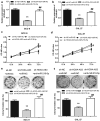Long non-coding RNA HOXA-AS3 promotes cell proliferation of oral squamous cell carcinoma through sponging microRNA miR-218-5p
- PMID: 34698001
- PMCID: PMC8806885
- DOI: 10.1080/21655979.2021.1978196
Long non-coding RNA HOXA-AS3 promotes cell proliferation of oral squamous cell carcinoma through sponging microRNA miR-218-5p
Abstract
Increasing evidence demonstrated long non-coding RNAs (lncRNAs) play important roles in the occurrence and development of oral squamous cell carcinoma (OSCC). This study aimed to explore the role and molecular mechanism of lncRNA HOXA-AS3 in the progression of OSCC. Here, we found that the expression of lncRNA HOXA-AS3 was upregulated in OSCC tissues and cell lines compared with the para-cancerous tissues and normal human oral keratinocyte (NHOK), respectively. Inhibition of HOXA-AS3 significantly inhibited the proliferation and colony formation of OSCC cells. Further, the luciferase reporter assay showed that HOXA-AS3 was directly bound to miR-218-5p. Moreover, the expression of miR-218-5p was negatively regulated by HOXA-AS3, and miR-218-5p could inhibit the expression of collagen type I alpha1 (COL1A1) and lysophosphatidylcholine acyltransferase 1 (LPCAT1). In addition, silencing miR-218-5p reversed the inhibitory effect of HOXA-AS3 knockdown on the proliferative potential of OSCC cells. In summary, our study illustrated that HOXA-AS3 promoted cancer cell proliferation in OSCC, possibly by sponging miR-218-5p for the first time, which provides a new target or a potential diagnostic biomarker for OSCC.
Keywords: HOXA-AS3; LncRNA; Oral squamous cell carcinoma; miR-218-5p; proliferation.
Conflict of interest statement
The authors declare that they have no competing interests.
Figures







Similar articles
-
The integrated comprehension of lncRNA HOXA-AS3 implication on human diseases.Clin Transl Oncol. 2022 Dec;24(12):2342-2350. doi: 10.1007/s12094-022-02920-w. Epub 2022 Aug 20. Clin Transl Oncol. 2022. PMID: 35986859 Free PMC article. Review.
-
LncRNA HOXA-AS3 Promotes the Progression of Pulmonary Arterial Hypertension through Mediation of miR-675-3p/PDE5A Axis.Biochem Genet. 2021 Oct;59(5):1158-1172. doi: 10.1007/s10528-021-10053-y. Epub 2021 Mar 9. Biochem Genet. 2021. PMID: 33687636
-
Targeting lncRNA PSMA3-AS1, a Prognostic Marker, Suppresses Malignant Progression of Oral Squamous Cell Carcinoma.Dis Markers. 2021 Aug 19;2021:3138046. doi: 10.1155/2021/3138046. eCollection 2021. Dis Markers. 2021. PMID: 34457087 Free PMC article.
-
HOXA-AS3 Promotes Proliferation and Migration of Hepatocellular Carcinoma Cells via the miR-455-5p/PD-L1 Axis.J Immunol Res. 2021 Dec 27;2021:9289719. doi: 10.1155/2021/9289719. eCollection 2021. J Immunol Res. 2021. PMID: 34988230 Free PMC article.
-
Tumour-regulatory role of long non-coding RNA HOXA-AS3.Prog Biophys Mol Biol. 2024 Jul;189:13-25. doi: 10.1016/j.pbiomolbio.2024.04.003. Epub 2024 Apr 7. Prog Biophys Mol Biol. 2024. PMID: 38593905 Review.
Cited by
-
The integrated comprehension of lncRNA HOXA-AS3 implication on human diseases.Clin Transl Oncol. 2022 Dec;24(12):2342-2350. doi: 10.1007/s12094-022-02920-w. Epub 2022 Aug 20. Clin Transl Oncol. 2022. PMID: 35986859 Free PMC article. Review.
-
Role of HOXA1-4 in the development of genetic and malignant diseases.Biomark Res. 2024 Feb 5;12(1):18. doi: 10.1186/s40364-024-00569-x. Biomark Res. 2024. PMID: 38311789 Free PMC article. Review.
-
Nuclear respiratory factor 1 drives hepatocellular carcinoma progression by activating LPCAT1-ERK1/2-CREB axis.Biol Direct. 2023 Oct 24;18(1):67. doi: 10.1186/s13062-023-00428-z. Biol Direct. 2023. PMID: 37875967 Free PMC article.
-
Downregulation of circLPAR3 inhibits tumor progression and glycolysis by liberating miR-144-3p and upregulating LPCAT1 in oral squamous cell carcinoma.Laryngoscope Investig Otolaryngol. 2022 Mar 11;7(2):425-436. doi: 10.1002/lio2.771. eCollection 2022 Apr. Laryngoscope Investig Otolaryngol. 2022. PMID: 35434335 Free PMC article.
-
COL1A1, mediated by m6A methylation of METTL3, facilitates oral squamous cell carcinoma cell growth and metastasis.Odontology. 2025 Jan;113(1):191-200. doi: 10.1007/s10266-024-00962-w. Epub 2024 Jun 20. Odontology. 2025. PMID: 38900231
References
-
- Nagao T, Warnakulasuriya S.. Screening for oral cancer: future prospects, research and policy development for Asia. Oral Oncol. 2020;105:104632. - PubMed
-
- Shrestha AD, Vedsted P.. Prevalence and incidence of oral cancer in low- and middle-income countries: a scoping review. Eur J Cancer Care (Engl). 2020;29(2):e13207. - PubMed
-
- Almangush A, Mäkitie AA, Triantafyllou A, et al. Staging and grading of oral squamous cell carcinoma: an update. Oral Oncol. 2020;107:104799. - PubMed
-
- Wang W, Adeoye J, Thomson P. Statistical profiling of oral cancer and the prediction of outcome. J Oral Pathol Med. 2021;50(1):39–46. - PubMed
MeSH terms
Substances
LinkOut - more resources
Full Text Sources
Other Literature Sources
Medical
Miscellaneous
